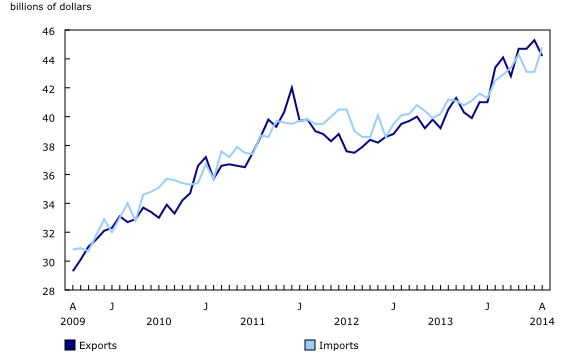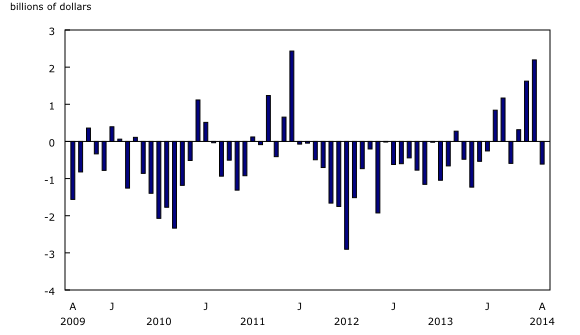Canadian international merchandise trade, August 2014
Archived Content
Information identified as archived is provided for reference, research or recordkeeping purposes. It is not subject to the Government of Canada Web Standards and has not been altered or updated since it was archived. Please "contact us" to request a format other than those available.
Released: 2014-10-03
Canada's merchandise imports rose 3.9% in August, while exports decreased 2.5%. As a result, Canada's trade balance with the world went from a surplus of $2.2 billion in July to a deficit of $610 million in August.
Imports rose to a record high $44.8 billion, led by metal and non-metallic mineral products as well as energy products. Overall, volumes increased 2.4% and prices were up 1.5%.
Exports decreased to $44.2 billion. Exports declined in 9 of 11 sections; the main contributors were motor vehicles and parts as well as energy products. Overall, volumes were down 1.8% and prices 0.7%.
Imports from non-US countries rise
Imports from countries other than the United States rose 9.3% to $15.1 billion in August. There were higher imports recorded for the principal trading area "all other countries" (+18.8%), primarily crude oil and crude bitumen. Exports to countries other than the United States declined 2.5% to $10.9 billion on lower exports to the European Union (-4.4%) and Japan (-9.9%). Canada's trade deficit with countries other than the United States widened from $2.6 billion in July to $4.1 billion in August.
Imports from the United States were up 1.4% to $29.7 billion. Exports to the United States declined 2.5% to $33.3 billion on lower exports of motor vehicles and parts as well as energy products. Canada's trade surplus with the United States narrowed from $4.8 billion in July to $3.5 billion in August.
Imports increase on higher volumes
Imports of metal and non-metallic mineral products rose 24.1% to a record high $4.4 billion in August, as volumes were up 18.6%. The main contributor to the increase in imports was unwrought precious metals and precious metal alloys (+92.7%). Also contributing were unwrought iron, steel and ferro-alloys, and basic and semi-finished ferrous metal products (+17.3%) as well as unwrought copper and copper alloys, which advanced $91 million to reach $131 million in August.
Energy products increased 20.8% to $4.3 billion, on the strength of volumes. Crude oil and crude bitumen was the main factor behind the gain, as imports were up 36.6% to $2.6 billion. Also contributing were higher imports of natural gas liquids and related products (+69.2%), which rose on higher prices and volumes.
Following three consecutive monthly declines, imports of consumer goods grew 4.4% to a record high $9.0 billion. Increases were widespread throughout the section, led by miscellaneous goods and supplies (+15.1%) and clothing, footwear and accessories (+6.6%). Overall, volumes were up 3.3% and prices 1.1%.
Imports of metal ores and non-metallic minerals increased 33.2% to $1.1 billion, entirely on higher volumes. Leading the increase in imports was the commodity grouping "other metal ores and concentrates" (+22.7%), primarily lead ores. Higher imports were also recorded for nickel ores and concentrates, up $76 million to reach $90 million in August.
Imports of motor vehicles and parts fell 7.2% to $7.2 billion, partially offsetting the overall increase in total imports. Motor vehicle engines and motor vehicle parts (-11.1%) and passenger cars and light trucks (-6.2%) were the main contributors to the section's decline. Historically, most automotive plants have shutdowns in July. However, this year, several plants reported shorter or no shutdowns during July, which led to an increase in seasonally-adjusted imports for that month, as well as a subsequent decline in August as imports returned to more normal levels.
Exports of motor vehicles and parts and energy products decline
Exports of motor vehicles and parts decreased 11.2% to $6.1 billion in August. Lower exports of passenger cars and light trucks, down 13.1% to $4.0 billion, was the principal factor behind the decline. Also declining was motor vehicle engines and motor vehicle parts (-8.6%). As with imports, most automotive plants have shutdowns in July. However, this year, several plants reported shorter or no shutdowns during July, which led to an increase in seasonally-adjusted exports for that month, as well as a subsequent decline in August as exports returned to more normal levels.
Exports of energy products declined 5.8% to $10.5 billion, as prices decreased 4.9%. Crude oil and crude bitumen was the main contributor, as exports fell 7.1% to $7.7 billion.
Partially offsetting these declines, exports of aircraft and other transportation equipment and parts were up 26.8% to $2.1 billion, the second highest value on record. Higher exports of aircraft (+45.4%) led the increase. The commodity grouping "ships, locomotives, railway rolling stock, and rapid transit equipment" also increased, up $143 million to reach $171 million in August.
Note to readers
Merchandise trade is one component of Canada's international balance of payments (BOP), which also includes trade in services, investment income, current transfers as well as capital and financial flows.
International merchandise trade data by country are currently available on both a BOP and a customs basis for the United States, Japan and the United Kingdom. Trade data for all other individual countries are available on a customs basis only. BOP data are derived from customs data by making adjustments for factors such as valuation, coverage, timing and residency. These adjustments are made to conform to the concepts and definitions of the Canadian System of National Accounts.
Data in this release are on a BOP basis, seasonally adjusted and in current dollars. Constant dollars are calculated using the Laspeyres volume formula (2007=100).
For more information on seasonal adjustment, see Seasonally adjusted data – Frequently asked questions.
More countries will be available on a BOP basis for trade in goods
The countries and country groupings for which Statistics Canada currently publishes data on a BOP basis will be replaced by a list of Canada's top 27 principal trading partners (PTPs). The list of PTPs is based on their annual share of total trade—merchandise imports and exports—with Canada in 2012.
Historical data based on the new list of PTPs for the reference period from January 1997 to December 2010 will be released on November 19, 2014.
The first regular release of data based on the new list of PTPs will be on December 5, 2014. This release will cover the period from January 2011 to October 2014. A calculated trade balance and the expanded list of PTPs will be featured in the new CANSIM table 228-0069.
A conceptual analysis of BOP versus customs-based data, titled Balance of Payments Trade in Goods at Statistics Canada: Expanding Geographic Detail to 27 Principal Trading Partners (PTPs), will be available to users in the fall of 2014.
Revisions
In general, merchandise trade data are revised on an ongoing basis for each month of the current year. Current year revisions are reflected in both the customs and BOP based data.
The previous year's customs data are revised with the release of the January and February reference months as well as on a quarterly basis. The previous two years of customs based data are revised annually and are released in February with the December reference month.
The previous year's BOP based data are revised with the release of the January, February and March reference months. To remain consistent with the Canadian System of macroeconomic accounts, annual revisions will take place in December with the October reference month rather than in June, as was previously the case.
Factors influencing revisions include late receipt of import and export documentation, incorrect information on customs forms, replacement of estimates produced for the energy section with actual figures, changes in classification of merchandise based on more current information, and changes to seasonal adjustment factors.
For more information on revisions for crude oil and natural gas, see "Revisions to trade data for crude oil and natural gas."
Revised data are available in the appropriate CANSIM tables.
These data are now available in the Canadian International Merchandise Trade Database (Catalogue number65F0013X). From the Browse by key resource module of our website, choose Publications.
The August 2014 issue of Canadian International Merchandise Trade, Vol. 68, no. 8 (Catalogue number65-001-X), is also available from the Browse by key resource module of our website under Publications.
Data on Canadian international merchandise trade for September will be released on November 4.
Contact information
For more information, contact us (toll-free 1-800-263-1136; 514-283-8300; infostats@statcan.gc.ca).
To enquire about the concepts, methods or data quality of this release, contact Alec Forbes (613-951-0325), International Accounts and Trade Division.
- Date modified:



